Fly Tying Blog by Joe Jackson
Photos by Gabe Smith
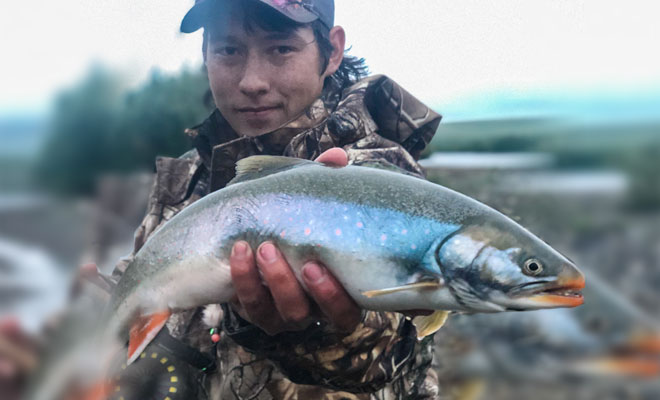
Smith and a gorgeous Nome-area dolly.
Fly-tying is a school you never graduate from. Edward Muzeroll
24-year-old Gabe Smith grew up the way most can only dream about: exploring the boundless stretches of ocean and tundra surrounding his hometown of Nome and living out the idyllic traditions of the Inupiat people. By the time Smith went off to college at the University of Alaska Fairbanks (UAF) in 2015, he’d mastered the arts of hunting, navigating, trapping, boatmanship, and fishing with conventional tackle. But there was one tool with which he wasn’t familiar, one that had been resting in the back corner of his closet for as long as he could remember: a fly rod.
Today, five years later, he can’t imagine fishing any other way.
Smith’s story marks the beginning of a journey. What started out as a crusade by yours truly to uncover the origins of popular flies has turned into a series of opportunities to speak with Alaska’s fly creators—both anonymous and well known. Since I moved and began flyfishing here in 2014, I’ve been fascinated by Alaska’s tools of the trade. It really started when I tried to locate the originator of the Salcha Pink (a famous Interior grayling fly), and since then I’ve wanted to know—in the same, pleasing way that we know Carrie Stevens invented the Gray Ghost or Don Gapen tied the first Muddler Minnow—who came up with what. Pulling back the curtain a bit, though, has had the effect of lifting a car hood. Things get complicated quickly.
I’ve always thought of Alaska as a sort of isolated, flyfishing think-tank. While anglers have been plying the waters of the eastern United States since the late nineteenth century (and those of Europe since the 1400s), the Last Frontier is comparatively new to the game. It wasn’t until 1959, when Alaska achieved statehood and synthetic materials like fiberglass and monofilament were mass-produced with regularity, that the first significant surge of fly-toters came northward.
What happened between then and, say, 1984 were a series of incremental advancements to flies and fly techniques. Most of the flies that anglers employed were just patterns from the Lower 48; Gapen’s Muddler Minnow, Russell Blessing’s Woolly Bugger, or traditional bucktails.
Enter the ‘80s, when hairstyles, rock n’roll, and flies all took quantum leaps. Will Bauer unveiled the Egg-Sucking Leech in 1984, and a young guide by the name of George Cook devised the Popsicle soon after. Just like fiberglass and monofilament in the ‘50s, synthetic fly-tying materials made for rapid advancement into the 21st Century. By 2015, when Gabe Smith tied his first fly, Alaskan flies were being concocted with everything from radioactive shades of marabou to tungsten hourglass eyes as heavy as dumbbells. Literally hundreds of nuanced flies, mostly for trout and salmon and all developed within the previous decade, had entered the market. It was a veritable bonanza for an eager fly tyer.
Gabe Smith plans to be a wildlife biologist. If all goes well, he’ll have his Bachelor of Science degree in May 2021, and he plans to return home to manage wildlife on the Seward Peninsula.
The impetus to learn the art of flyfishing came as a result of one of Smith’s wildlife scholarships. The award required the addition of just one credit to his workload, but as Smith would come to find out, there are very few suitable one-credit classes available within just a few weeks of a new semester. Luckily, he stumbled upon one which fit the bill perfectly: a flyfishing course, developed and taught by instructors Shann Jones and Scott Murdock.
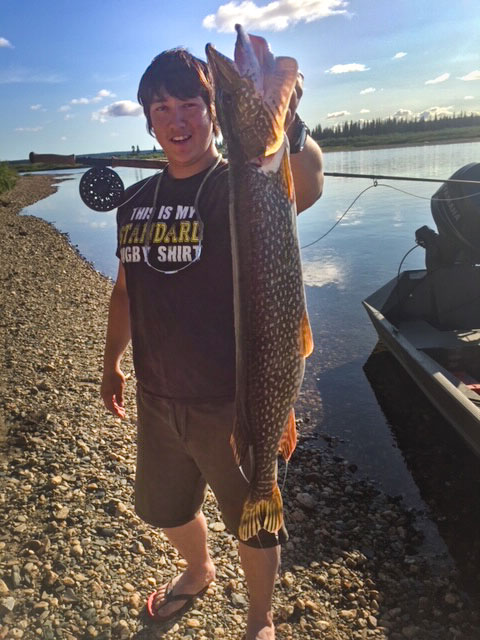
Gabe Smith in his element: field testing flies during the long days of summer.
Smith spent the fall semester learning the basics of casting, mending, and the sundries of fly tying. He went from wrapping together simple Brassies in August to creating immaculate Sparkle Duns in December, and by January of the following spring semester, he was ready for the advanced class. In this iteration, not only did students learn sophisticated tying techniques like spinning deer hair or counter-wrapping tinsel on Atlantic salmon flies, but they were required, for a final project, to devise their own patterns. Smith found the whole experience to be revolutionary and has been tinkering with his own flies ever since, taking what he’d learned from Jones and Murdock and adapting it to his home waters of Nome. He made such an impression, in fact, that when I talked with Scott Murdock about Murdock’s immaculate Atlantic salmon flies just a few weeks ago, he told me I had to get in contact with “this kid from Nome.”
“He’s doing some neat things,” I was told.
This is where my conversation with Gabe Smith began. It was a dark December evening—a typical way to begin any Alaskan tale—when I gave him a ring, and it didn’t take us long to realize that we probably crossed paths several times during our stints in Fairbanks (I got my wildlife degree from UAF in 2017). Right off the bat I could tell that Gabe Smith was a thinker, a creator, and a modest one at that. He assured me that he hasn’t done anything special besides take established patterns and tweak them to better suit the fisheries around Nome. I wanted to tell him that this is exactly where true pioneers begin, and that someday I’ll probably be buying Gabe Smith originals from Orvis, but I let him continue with his stories.
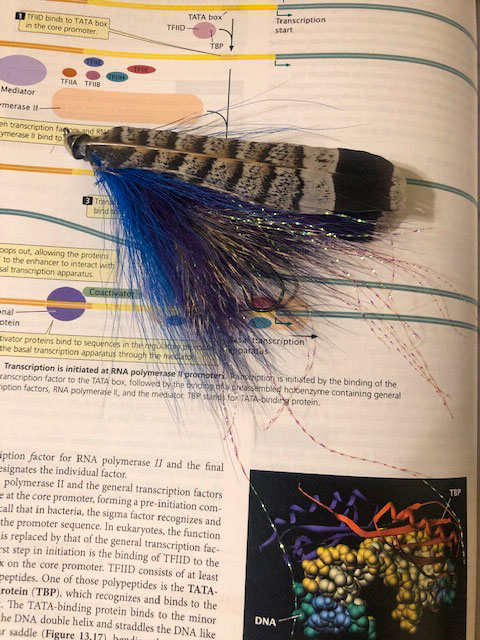
Smith’s pike creation shown with some of the genetics homework he put off tying it.
Upon completing the advanced portion of the tying class (and his spring semester), Smith returned to Nome for a summer job as a fisheries technician. This employment proved to be conducive to prolific fly research. He’d spend the days counting fish and the evenings tying and testing flies, bringing the unbridled zeal of a beginner combined with the discerning mind of a scientist. It was during this process that Smith learned it was critical to control variables.
“You don’t test a fly and change three or four things at once,” he tells me. “You tweak one thing at a time and see how it works, what it does.”
The first of Smith’s adjustments was for an invention of Scott Murdock called the “Momo.” In its original form, this fly is composed of chenille and bright bunny strips tied around a tube. Upon returning home, Smith sampled the area’s coho fishing with the Momo and found it effective, but he didn’t like the way the tube slid up and down the leader or how the hook would sometimes get jammed in the tube. He spent the next several weeks watching YouTube videos by the popular company Olympic Peninsula Skagit Tactics (OPST) and adapted the Momo to be tied on an Intruder shank. Not only did this process make the Momo easier to fish, but it marked the beginning of Smith’s insidious obsession for spey fishing and articulated flies. Over the next several summers, time that wasn’t spent watching salmon pass by the weirs became consumed with dubbing loops, more OPST YouTube videos, or pricing ostrich herl online. Smith also purchased his first spey setup.
Like many others before him, Smith is drawn to fly tying for the self-sufficiency it gives him. He soon realized that he could tie as many flies as he wanted—being limited only by materials and time—and that he could make them exceedingly tough to see how many fish he could catch on one fly before it crumbled and unwound itself. Smith is a tyer who loves thread wraps and head cement.
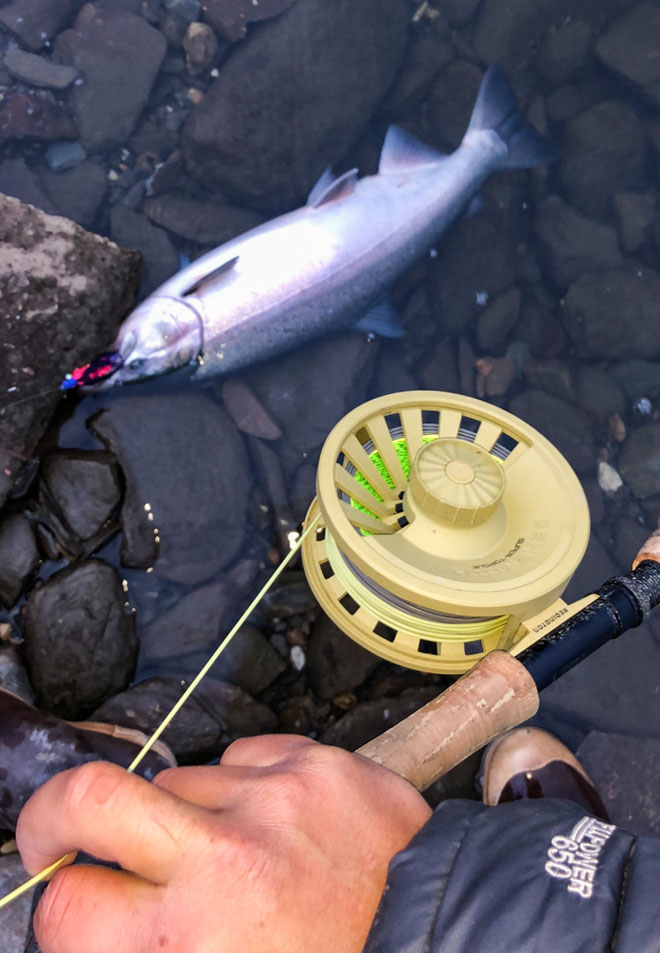
A dime-bright coho that fell victim to one of Smith’s articulated patterns.
The first original creation Smith tells me about is an unnamed pike fly. During the advanced fly-tying class, he got tired of spinning copious amounts of deer hair only to clip most of it off. He soon figured out that caribou or moose hair was more durable and buoyant than deer anyway (a useful discovery for targeting the Nome area’s titanic grayling), and he decided to spin the hair and leave it an untrimmed mess. He then tied in two whole ruffed grouse tail feathers, rounding out a creation that looks mildly absurd but with its own distinct, Alaskan charm.
“Have you fished it?” I have to ask.
“Not yet,” Smith says. “It ended up looking so good that I gave it to a friend on their birthday.”
I’m waiting to hear how the next model fishes.
Smith proceeds to distill days, months, years of fly tying into the next hour or so. The sky somehow gets darker outside, snow begins to fall, and I find myself longing for the feeling of fly line in my hands. We talk about Arctic grayling (Smith’s largest comes in at 22 ½ inches) and spring smolt runs. Smith describes the spectacle of Dolly Varden and Arctic char chasing salmon fry through the Bering estuaries as “something to see.” The fish just swim with their mouths open, scooping up smolt with wanton joy. Naturally, Smith realized that the optimal fly for such a phenomenon had to be something simple to tie and only faintly resembling the pearlescent sheen of young salmon, and his solution became a long-shanked hook wound with nothing more than silver tinsel. These flies could take less than a minute to tie, and their passing resemblance to seasonal forage made them irresistible to trophy-sized char. Wanting to perfect the fly even further and come up with something that could last him from “ice-out all the way through late June,” Smith added a spot of red thread at the butt of the fly. This addendum gave the fly enough likeness to Arctic bloodworms, which char and grayling feed on with fervor during the summer, to make it doubly effective.
At last, we reach a fly that I can tell Smith is distinctly proud of. He tells me about Nome’s outstanding (and somewhat covert) coho fishing, and then he tells me about the evolution of his salmon tactics. First it was the Momo, then it was a series of Intruder-style patterns, now it’s a sterling creation that, in angler-speak, really “knocks ‘em dead.”
Smith describes it as small; it’s got two rubber legs at the back, a body of polar chenille, a collar of partridge, and a Fish Skull head. At first, it sounds a little too simple to be consistently effective, but then again, I’ve realized that Smith’s genius is his minimalism.
“What’s it called?” I ask, pen hovering over my notebook.
There’s a pause, and I can imagine Smith donning a boyish grin at the other end of our phone call.
“The Coho Cooter.”
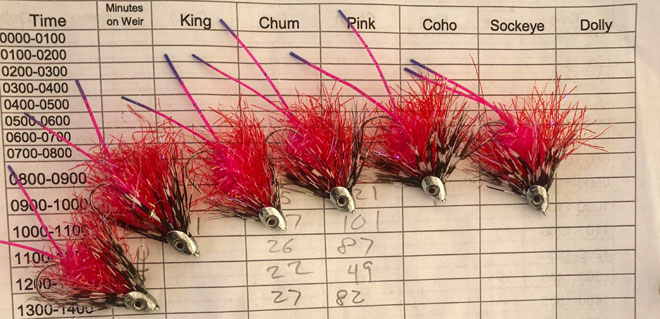
The tantalizing Coho Cooter, tied in between bouts of fish counting.
Good humor aside, this is Smith’s signature fly, and he wastes no time in presenting me the sales pitch. Small and compact, the Cooter achieves the tantalizing jigging action indicative of bulkier patterns like the Dolly Llama (or the Momo, for that matter), but in a much more castable payload. Smith tells me it’s particularly effective in slack water, and a few days later, he sends me some old photos to prove it. I start making wistful plans to check out Nome’s coho fisheries just as soon as I can, and to put in an order of a dozen Coho Cooters for statewide testing this next summer.
My final question of the night is all-too predictable: “What’s next for you?”
Gabe Smith isn’t the kind of guy to sit still for very long, nor one to accept anything as “good enough.” It’s as Da Vinci said: “Art is never finished, only abandoned.” There are always more flies to tie or flies to tweak.
His fly rod doesn’t sit in the closet for very long anymore. Maybe it rides out the winter there, but just as soon as the ice melts, the worn cork and the scintillating graphite are extracted, worked back and forth like a scythe, employed within Smith’s hands as though he’s been doing it all his life. Come May of this coming spring, he’ll graduate from one school but remain hopelessly interred within another.
Smith jots off a list of “maybes” that sound oddly like my own fishing goals; that he’d like to catch a king salmon, tie a few flies that are worthy of being framed, refine his lineup of spring smolt patterns, and generally improve his fly-tying technique. There’s the smolt run and the cohos, of course, to focus on; pike and grayling to cast for. Finally, he tells me that there are some gargantuan Arctic char that roam the waters near Nome in the fall, and that his priority for the coming season is to develop a fly to reliably catch them with.
“It’ll probably take me awhile, and there will be a lot of trial-and-error,” he says, but even through the 600 miles of static between us I can hear the hope in his voice. “I’ll just have to take it one fly at a time.”
Joe Jackson is a fly nerd who wishes to thank each and every subject of “Behind the Vice” for indulging his curiosity. Joe has written for Fish Alaska, The Flyfish Journal, The Drake, and American Fly Fishing, and his favorite fly to tie is a toss-up between the Splitsville Caddis and the classic Hare’s Ear.


